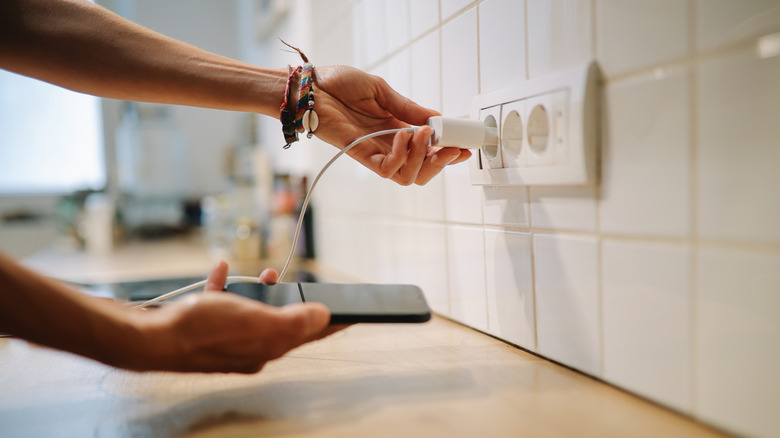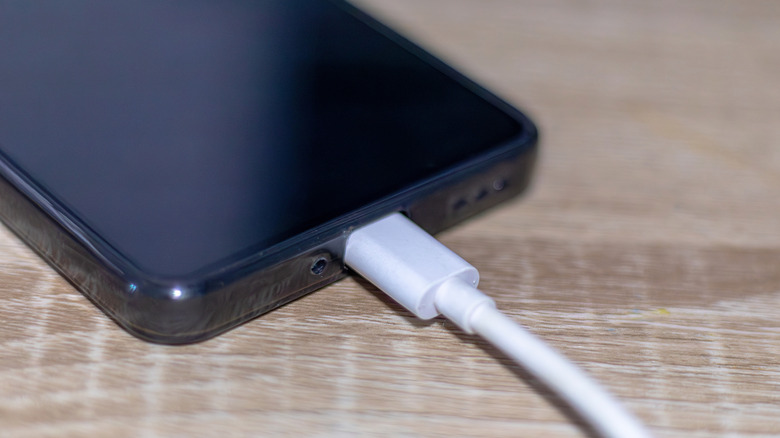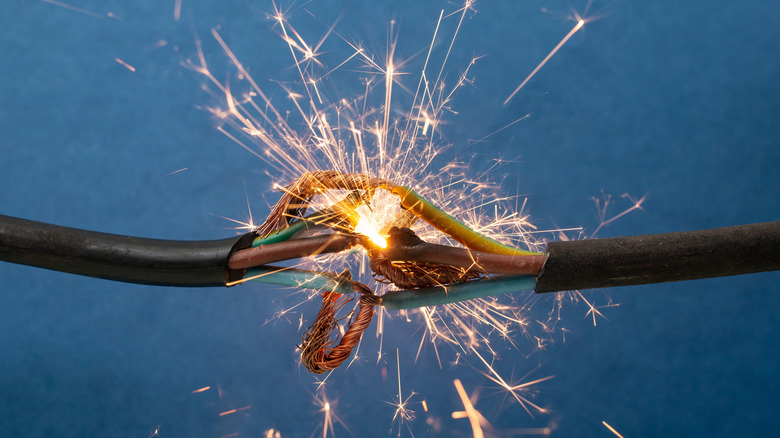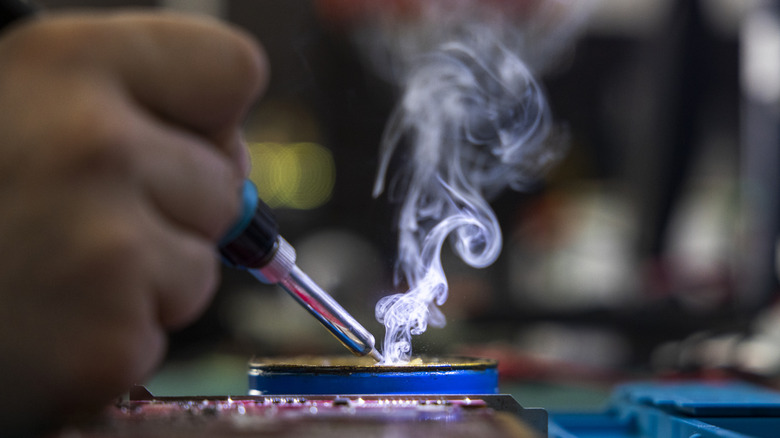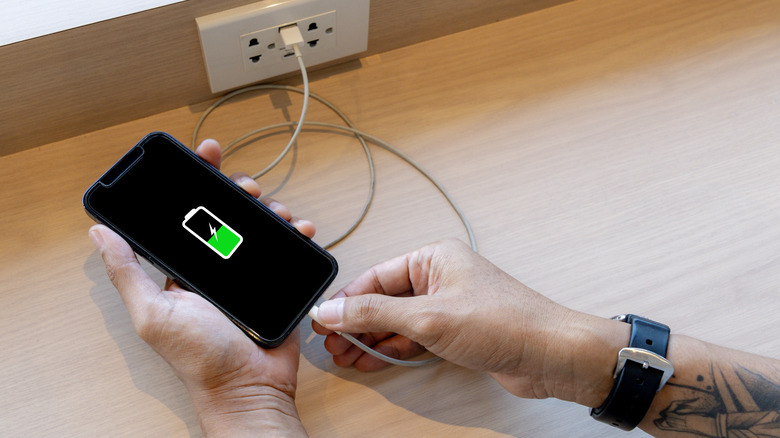Why Buying A Cheap Charging Plug Could Be A Dangerous Mistake
There are plenty of reasons to consider a cheap charging plug. Good chargers can cost more, so the price is probably the most in-your-face perk of a lower-quality cable. When you're shopping online, it's easy to go for the cheapest item, especially if it arrives quickly. Even in cases where you're shopping in-store, price is a motivating factor. Trustworthy cord and charger brands can come with heftier price tags, but what if we told you that paying a bit more is worth it?
The problem is that cheap charging plugs may not meet the strict industry standards that make charging cables generally safe to use. For example, the FCC regulates the emission of radio frequencies from electronic devices, and an unregulated device may produce interference. Not only that, but cheaper plugs may not be as efficient as you would hope.
Apart from having to buy a new cable when the cheap one you have ultimately fails, what are the other reasons you should avoid cheap cables? We're glad you asked.
An inadequate capacitor can lead to live electrical output
You might notice that if you own a cheaper, off-brand charging cable, that it often gets hot. Sometimes, that can be an inconvenience. It could seem like you've left your phone charging too long. Whether you're using your phone while it's charging or not, a hot cord could be a sign of a problem — and it's not normal at all.
Excessive heat in a counterfeit phone charger can lead to electrical shock, according to an investigation by Electrical Safety First. The research found, among other issues, that knockoff charging plugs contained parts that were not up to standard for safety and electricity guidelines.
Where a distance of 5mm between accessible parts and the live voltage in the device was required, for example, the counterfeit examined by the investigators only had 1mm of clearance. Such a minute distance could result in contact of live wires, subjecting the user to a painful zap, or worse.
A cheap plug can set your house on fire
If your cheap charging cable getting hot isn't worrisome enough, consider the fact that it could also catch on fire. Once it starts, your entire house could go up in flames. How real is the risk? Very, according to news reports and the U.S. Consumer Product Safety Commission, which warned against off-brand chargers for e-bikes due to fire hazards. But it's not just e-bike chargers. The CPSC essentially says not to buy universal charges for micromobility products, due to the fire risk.
Compatibility issues can lead to a fire risk, according to a number of sources. For example, energy overload can overheat devices and cords, according to one news report. Depending on how fast chargers deliver power, you could end up with an overload that leads to fires.
The problems don't end with chargers that plug into wall outlets, either. Wireless chargers and power banks, both corded and non-corded, have caught on fire. Some portable chargers overheat, causing hazards for consumers. Poor-quality batteries and lack of thermal protection are often to blame. That's part of the reason why the E.U. has specific rules for power bricks.
Improper soldering can lead to a destroyed phone
Phone chargers use AC/DC power conversion, and there isn't much to get excited about. However, despite the simplicity of a basic phone charger, there are plenty of ways things can go wrong. For one thing, improper soldering or assembly can lead to problems, risking your phone's destruction. In a cheap charging cable or plug, wires that aren't soldered correctly can get loose. A free wire inside the charger could short circuit components in the charger or your phone.
If a live wire touches an internal component of the charger, that makes the entire unit electric, which could mean lights out for your device. So not only are there very real fire and electrical shock risks with cheap chargers, but they could destroy your smartphone.
Unfortunately, even if you have phone insurance, a faulty cable could veto your claim. With Apple, for example, the only charging cable they cover for insurance purposes is the one that came with your device. Even if you find chargers compatible with the iPhone, you should verify certifications and read the fine print. Most iPads come with chargers, at least in the U.S., and there are vetted charger brands for iPhones that will offer peace of mind.
Cheap plugs can break inside a wall socket and cause damage
As you've figured out by now, off-brand plugs don't always meet safety and efficiency certifications. Generally, certification processes can cost a company money, so it makes sense that a cheap charging plug could result from a company that's trying to save money by avoiding regulatory requirements.
If you skip out on certified chargers, it's hard to say what could go wrong, but safety and efficiency are crucial elements that third-party labs look at. For example, Underwriters Laboratories (UL) certifies that products are safe and efficient. Intertek (ETL) certifies that products meet North American safety standards.
There is also a nationally-recognized testing laboratory program managed by Occupational Safety and Health Administration (OSHA) that helps companies ensure their products are safe, and provides labeling to that effect for consumers. Unfortunately, cheaper products could fake certification, so it's important to check for certifications and avoid counterfeits. In the absence of these certifications, a cheap charging plug could fail to perform, and even break off into a wall socket.
Cheap counterfeit plastic can burn and turn toxic
In a deep dive into counterfeit charging plugs, Electrical Safety First found that knockoff charging plugs contained subpar components. For one thing, rather than using a durable polycarbon material for the charging plug, a counterfeit accessory instead used a poly-ABS. Not only is the material cheaper than alternatives, but it's also less durable.
There are zero fire-retardant properties in poly-ABS, and the smoke that it gives off when it does catch fire is toxic. If worrying about fires wasn't enough, your cheap plug could also give you breathing problems if it catches fire and billows smoke into your house.
As your user manual no doubt states, using a compatible charging plug is essential to safely and efficiently charging any device. But it pays to go beyond the basics and look for a charging plug that is not necessarily expensive, but does carry the appropriate certifications and, preferably, a positive reputation in the industry.
